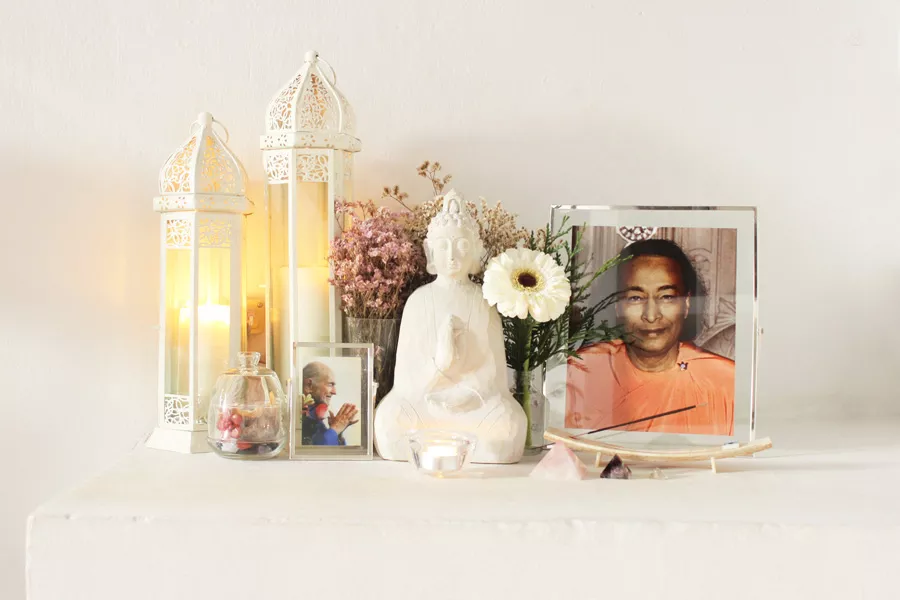How to create a good altar with Feng Shui
In this post I will give you 5 basic key points on how to create a good altar with Feng Shui. However, I also recommend you this other post where I explain how to create a good altar with Vastu Shastra. (If you have never heard of Vastu, it is like “the yoga of architecture”. Here I explain its similarities and differences with Feng Shui)
It is always useful to have at home a holy space to switch off from your daily life and connect with yourself. A place to think, meditate, relax, pray, make offers and so on. That’s part of the slow life spirit, to dedicate some time for ourselves in our busy daily life. An altar is a sacred space; it could mean a place of comfort, a refuge or a sanctuary.
The one you see in the picture is the one I have at home, full of meaning for me and made with lots of love. You may not like it but is perfect for me so is up to you to determine what works for you as everybody is different. When you think about Divine energies or blessings…What images, colours or symbols are coming to your mind? Get images or items that speak to you about love, devotion, protection or any other feeling associated by you with the Divine. That is a good exercise to start with.
I will give you here 5 basic and common key points about how to create a good altar with Feng Shui to get a harmonious and inspiring one in your home. Here we go!

-
Best location and orientation:
It’s important to choose a quiet place that doesn’t have any other use or activity to disturb the energy of the altar. Its place should be higher than the floor level, best to find a space on a shelf or on a table surface. Feng Shui-wise, it is excellent if you can have your altar in the Northwest area of your house but if that’s not possible, locate it following the bagua grid.
Yogis say that there are certain magnetic currents which flow from East to West. If you face East when you meditate, you will receive these currents; they will help you to attain inner enlightment. North, too, is said to be a good direction; facing in this direction in meditation helps one to become mentally free of physical limitations.
*Places to be avoided:
- A staircase above the altar is an act of disrespect as the altar is being walked over by someone who traverses the stairs.
- An exposed beam on top of the altar will subject it to pressure.
- A bed placed above an altar does not accord due respect to the altar, especially when is a marital bed.
- It’s important that you know where your altars objects are from because, for example, that lovely figure may be connected to a sad story.
-
Essential elements:
An altar can be as elaborate or simple as you want. Traditionally, the most consistent components found in the creation of a good altar is the representation of the four elements: Fire, Water, Earth and Air. So you can represent these elements by some powerful and important items that all altars should have:
- Fire: Candles, representing the divine spark or holy fire within.
- Water: A water bowl as representation of fulfilment.
- Earth: Gemstones, crystals…they represent the abundant earth element.
- Air: Incense or essential oil burners, representing the unity with Creator and Divine consciousness. The incense will clear the immediate and surrounding areas of your sacred space of any negativity and allow your mind to re-focused from distracting influences. It is important to choose a fragrance that we like to feel in harmony with the aroma.
There are some other basic elements that bring a holy spirit to the altar, such as:
- Statues: many altars contain a statue of a chosen deity for focus.
- Pictures: placing a picture of something dear to us, symbolizes our heart.
- Flowers: they can be placed as an offer and always bring a nice energy. They represent the Mother Nature and beauty.
- Prayer Beads, Mala, Rosary: are used as a focus for the prayers.
- Pyramid: symbolizes revelations, ancient mysteries.
-
Favourable time to set it up:
My friend Luna Dominante says that the moon is perfect to start new projects so please have a look to the calendar to do it with the moon in this phase if you are going to set it up from scratch. If you already have one and just want to make some adjustments to make it perfect then do it with full moon.
-
Offering suggestions:
An offering to your altar signifies your gift to the Universe. Each culture has a variety of offerings which can be utilized. Here you have a few suggestions:
- Corn: in many cultures represents harvest and abundance
- Flowers: represents an emblem of the Divine
- Fruit: symbolizes the feminine spirit and harvest
- Grain: symbols of prosperity and renewal
- Rice: Good fortune
- Salt: purification and resurrection
- Water: representation of cleansing and spiritual atunement.
- Wine: symbols of the blood of life and eternal fire.
-
Maintenance:
It’s important to clean the altar very frequently and if you have fresh flowers in it, to replace the water every day. The energy has to move and you should change the altar items when you feel you are not longer comfortable with these items.
I hope all this is useful for you!
* If you want to expand the information, I recommend you reading how to create a good altar with Vastu Shastra. Vastu has points in common with Feng Shui but its methodology, based on the wisdom of the Vedas, is different.
Many blessings on you!
Julia
*Photo: Dalalba

